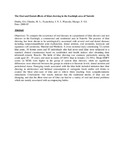| dc.contributor.author | Dimba, EA | |
| dc.contributor.author | Chindia, M. L. | |
| dc.contributor.author | Nyanchoka, I. N. I. | |
| dc.contributor.author | Wanzala | |
| dc.contributor.author | Macigo, F. G.I. | |
| dc.date.accessioned | 2013-02-20T15:07:47Z | |
| dc.date.issued | 2008-05 | |
| dc.identifier.citation | The Journal of Kenya Dental Association (JKDA) Voll. No.1 May, 2008. | en |
| dc.identifier.uri | http://erepository.uonbi.ac.ke:8080/xmlui/handle/123456789/10518 | |
| dc.description | The oral and dental effects of Khat chewing in the Eastleigh area of Nairobi. | en |
| dc.description.abstract | Objectives: To compare the occurrence of oral diseases in a population of khat chewers and non chewers in the Eastleigh, a commercial and residential area in Nairobi. The practice of khat chewing has been shown to be aetiological1y associated with several oral and dental diseases including temporomandibular joint dysfunction, dental attrition, oral stomatitis, keratosis and squamous cell carcinoma.
Material and Methods: A cross sectional study constituting 72 current khat users, 10 former users and 85 individuals who had never used khat were subjected to a standard clinical examination based on established oral health indices after obtaining their informed consent.
Results: The habit of khat chewing was common, particularly among the youth aged 20 - 39 years; and more in males (67.60%) than in females (32.39%). Mean DMFT scores (± SEM) were higher in the group of current khat chewers, while no significant differences were observed between the groups in relation to fluorosis levels, dental attrition and periodontal status. Emerging trends associated with the khat habit included initiation into khat chewing in adolescence and habitual consumption of cariogenic foods andlor soft drinks to counter the bitter after-taste of khat and to relieve thirst resulting from sympathomimetic stimulation.
Conclusions: Our results indicate that the traditional modes of khat use are changing, and that the short term use of khat can lead to a variety of oral and dental problems which are mainly associated with accompanying habits. | en |
| dc.language.iso | en | en |
| dc.relation.ispartofseries | Voll. No.1 May, 2008.; | |
| dc.subject | khat (miraa), drug abuse, youth, Kenya, oral and dental effects. | en |
| dc.title | The Oral and Dental effects of Khat chewing in the Eastleigh area of Nairobi | en |
| dc.type | Article | en |
| local.publisher | 1 Department of Oral and Maxillofacial Surgery, Oral Pathology and Medicine, School of Dental Sciences, University of Nairobi, | en |
| local.publisher | 2 Kenya Medical Research Institute | en |


